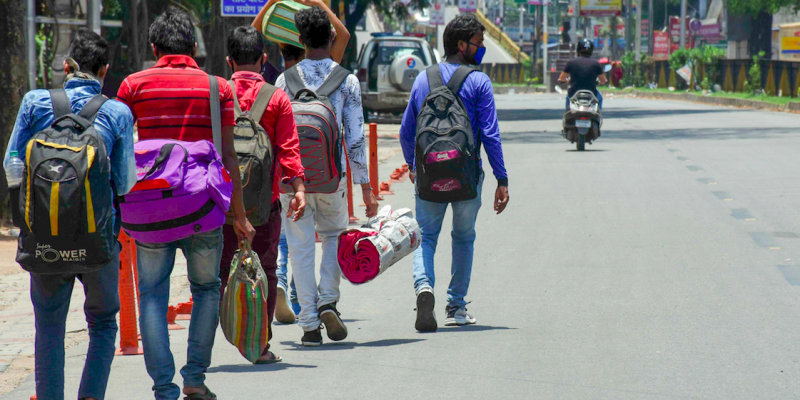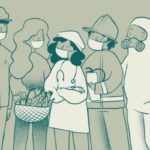Tum abhi shahr mein kya na.e aaye ho/ ruk gaye rah mein hadsa dekh kar
“You seem to be new to this city/ you halted in your tracks when you saw an accident.”
So writes the Urdu poet Bashir Badr. The stanza is a searing and damning indictment of the soullessness of the city, of the cynicism of the city-dweller. There was a time when the city was seen as the epitome of modernity. It was the space of freedom. People could drop their second name and escape caste discrimination. The city was the site of opportunities that enabled everyone to live a better life. It was the place where people entered into flexible relationships of their choice. The glittering image of urban spaces set off a steady stream of migrants to Indian cities and towns.
But experience of the urban sadly belied expectations and dreams. Once migrants manoeuvred some space for themselves in a shantytown defined by filthy open drains, overflowing garbage and ramshackle shelters made of cardboard and roofed with asbestos, once they found employment in the sweatshops of the informal economy that churn out consumer seductions from exotic breads to even more exotic designer clothes, the migrant begins to long for home. The memorable lyric ‘Seene mein jalan, ankhon mein toofan sa kyu hain/is shahar mein har shaks pareshan sa kyu hain?‘ (“Why is everyone so disturbed in this city, why does the heart smoulder and eyes fill with stormy emotions?”) forms the backdrop to urban alienation experienced by the Mumbai taxi-driver, played by Farooq Shaikh in Muzaffar Ali’s unforgettable film Gaman (1978). It is not the shanty-town dweller alone who suffers from alienation. Recollect the marvellous film The Lunchbox (2013) starring Irrfan Khan. There can be no better representation of urban loneliness.
All was never well with the city. The work of littérateurs, urban sociologists, poets and psychiatrists was ambivalent about the urban. The city offers avenues for personal advancement, for material gains and for freedom. It is the space of progress, innovation and social change. But it is also the domain of the impersonal, frightening anomie, isolation, loneliness and mental disorders. The discipline of psychiatry was the product of the urban condition. The German urban sociologist Georg Simmel (1858-1918), in his famous The Metropolis and Mental Life (1908), gave voice to the ambivalence that forms the heart of the city. The city, he wrote, might offer opportunities for personal advancement. It is also the source of over-stimulation and tyranny of the material. The only way people can connect to others and perhaps to themselves is through the currency note.
India as always defied the assumptions of western scholarship. Here there is no specificity to the urban condition. For many Indians, the city replicates the oppression of the rural. Mohandas Naimishray observed in Apne Apne Pinjre (2000) that though Bombay had huge poverty and unemployment, there were no walls that separated men from men. There is no caste in the city, he concluded. But caste creeps silently but surely into his life, it shapes his experience of the urban. He notes that the temple does not allow Dalits to enter. The stigma of untouchability remains, even if the oppression is not as brutal or blatant as in rural environments. Dalits still have to hide their caste to get things done. They have to opt for namelessness if they wish to live in an upper caste colony. If they are, perchance, found out, they will be asked to leave.
Also read: In Photos: The Migrant Labourers of the Industrialised Hinterland

Migrants arrive in Hooghly from Ajmer on a special train. Photo: PTI
Perceive the supreme irony. Migrant labour builds cities but the city has no place for them. And then comes a time when disease strikes the country. The economy is locked down, pitiless owners of small capital shut their doors on workers, callous landlords demand rent from penniless tenants, food is short, and the rulers exhibit callousness towards the most vulnerable sections of their own people. The Indian economy rests on the shoulders of migrant labour. But the economy, the polity and society are indifferent to the needs of the worker. The idea that the city could ever make its inhabitants its own fades. In its place is recalled a space called home. The notion of the home has been critiqued by feminists, but for those labouring under the burdens of an exploitative economy and society, home represents belonging and familiarity.
It is this notion of the home that thousands of migrant workers carry with them as they walk the highways of the country with torn and bloodied feet, backs bent under the weight of their pitiful belongings, eyes dimmed by loss of hope, bellies distended by hunger and throats parched because of lack of water. If they have a little money, they might travel on a passing truck. Most of them have no money, nothing except the hope that when they reach home they will not be hungry. Every expectation that the city might offer refuge in times of crisis has been relegated to the wayside. But Indian villages that beckon thousands of workers are not the embodiment of idyllic Ruritania, nor are they the rural Utopias presented in Bollywood films of the 1960s. For the most part, life in the Indian village is marked by desperation and deprivation. And yet for millions of people who work in bleak urban spaces, their village is home.
This might be a reassuring thought because the modern condition has been one of homelessness ever since the industrial revolution forced people to leave their homes and hearths. Karl Marx wrote of this moment in human history thus: “all fixed, fast-frozen relations with their train of ancient and venerable prejudices and opinion are swept away, all new-formed ones become antiquated before they can ossify. All that is solid melts into air, all that is holy is profaned.”
Marx crafted the epitaph of immense social dislocations of the 19th century. Farmers left their fields, and people their homes and migrated to other places, be it the city or another country. The century was marked by the movement of Russian peasants to the towns, the Irish to New York and Chicago, the Prussians to Berlin, the Tamil sent as indentured labour to South Africa and the Caribbean, and the forced migration of the Chinese to South East Asia as labour. The future, it became clear, was an urban one.
Also read: Perception, Legality and Politics of the Migrant Worker Crisis in Lockdown
But like the market, the city has place only for those who can buy and sell. It has no place for those who cannot buy and who have nothing to sell. This became evident when in March 2020 the government deserted the most vulnerable section of our people. And we failed to recognise the enormity of the humanitarian crisis that was unfolding before our eyes.
‘Karvan guzar gaya gubar dekhte rahe‘ (“The caravan passed and we watched in silence the dust churned by the travellers”). As thousands of workers wend their way towards their homes, we realise that the city can never be a home. It is the source of mental disorders and disruption of community. The village, where farmers struggle against manifold deprivation, cannot also be home in the sense of belonging. Where then is home? Or is home an illusion that rescues us from debilitating loneliness and alienation?
Neera Chandhoke is former professor of political science, Delhi University.




